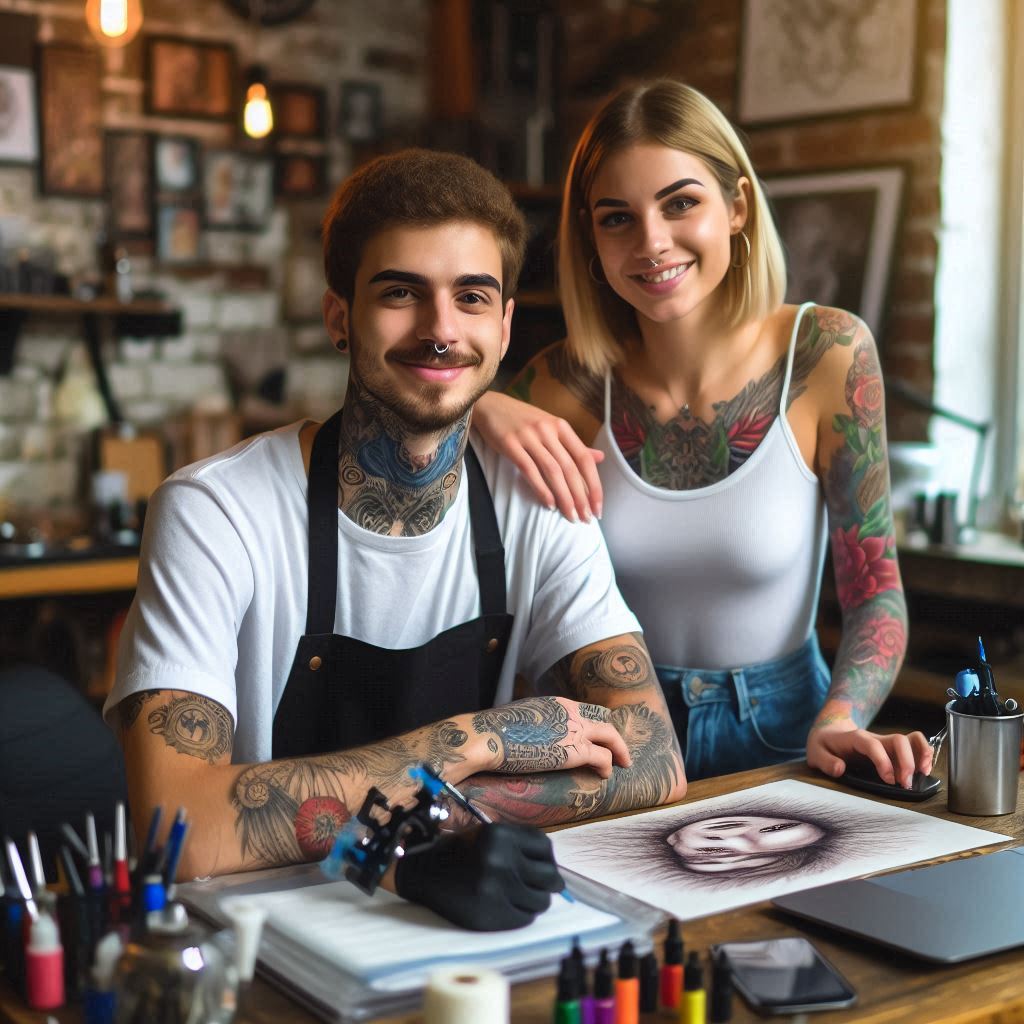Introduction
Health and safety protocols are vital in the tattoo industry.
These guidelines protect both artists and clients from potential health risks.
Tattoos involve needles, ink, and skin, which can lead to infections or allergic reactions.
Without proper protocols, these risks can escalate, causing serious health issues.
Inadequate sanitation can expose clients to bloodborne pathogens, such as HIV and hepatitis.
Tattoo artists must maintain strict hygiene practices to minimize this risk.
Using sterilized equipment and disposable needles is essential for every procedure.
Failure to do so can lead to severe consequences, including legal actions and loss of professional reputation.
Infections can arise if artists do not follow aftercare instructions.
Clients may experience complications that could result in permanent damage.
Therefore, educating clients on proper aftercare is crucial.
Additionally, artists should ensure their work environment is clean and organized.
Ignoring health and safety protocols can also result in financial repercussions.
Tattoo shops may face fines or closures due to non-compliance with health regulations.
Maintaining high standards not only safeguards health but also enhances the business’s credibility.
In essence, adhering to health and safety protocols is non-negotiable in the tattoo industry.
By prioritizing these practices, artists protect themselves and their clients, ensuring a safe and positive experience for everyone involved.
Proper Sterilization Techniques
Sterilization in tattoo studios is crucial to prevent the spread of infections and diseases.
Autoclave Use and Importance in Sterilizing Equipment
Tattoo artists prioritize health and safety through strict sterilization protocols.
Proper sterilization techniques ensure the safety of both clients and artists.
Transform Your Career Today
Unlock a personalized career strategy that drives real results. Get tailored advice and a roadmap designed just for you.
Start NowOne key method is the use of autoclaves.
An autoclave is a device that uses high-pressure steam to sterilize equipment.
It eliminates bacteria, viruses, and fungi from tools.
Tattoo artists should always sterilize reusable equipment before each use.
This step prevents infections and ensures a safe experience for clients.
Regular maintenance of autoclaves is crucial.
Artists must check the equipment for proper functionality.
They should conduct routine tests to confirm effective sterilization.
Following manufacturer guidelines helps maintain optimal performance.
Single-Use Items and Proper Disposal Procedures
In addition to sterilizing tools, tattoo artists must utilize single-use items.
These items include needles, ink caps, and gloves.
Single-use items reduce the risk of cross-contamination.
Artists must never reuse these items for multiple clients.
Proper disposal of single-use items is essential.
Tattoo artists should place used needles and other hazardous materials in puncture-resistant containers.
These containers prevent accidental injuries and maintain a safe workspace.
Following local regulations for disposal ensures compliance and safety.
Additionally, artists should educate clients about their sterilization practices.
Transparency builds trust and reassures clients of their safety.
Artists should encourage clients to ask questions about their processes.
Transform Your Career Today
Unlock a personalized career strategy that drives real results. Get tailored advice and a roadmap designed just for you.
Start NowThis open communication fosters a positive experience.
Overall, proper sterilization techniques protect everyone involved in the tattoo process.
Artists must consistently implement these protocols to ensure a safe environment.
By prioritizing health and safety, tattoo artists enhance their professional reputation and client satisfaction.
Read: The History of Tattoos: Cultural Significance
Artist hygiene practices
When it comes to tattoo artist health and safety protocols, there are several key practices that must be followed to ensure a clean and safe environment for both the artist and the client.
Here are some important guidelines to keep in mind:
- Regular Handwashing: One of the most crucial aspects of maintaining hygiene in a tattoo studio is ensuring that artists wash their hands thoroughly before and after each tattoo session.
- Glove Use: Artists should always wear disposable gloves while tattooing to prevent the spread of bacteria and viruses.
The Importance of Handwashing and Glove Use
Handwashing is essential as it helps remove dirt, bacteria, and viruses from the hands, which can easily be transferred to the client’s skin during the tattooing process.
Gloves provide an extra layer of protection and prevent direct contact with bodily fluids.
Emphasis on Clean Work Areas and Surfaces
- Cleanliness: It is imperative to keep work areas, surfaces, and equipment clean and sanitized to prevent the spread of infections.
- Disinfection: All tools and surfaces, including tattoo machines, chairs, and countertops, should be thoroughly disinfected between each client.
By following these hygiene practices, tattoo artists can create a safe and healthy environment for themselves and their clients.
Remember, cleanliness is key to preventing infections and ensuring successful tattooing outcomes.
Overall, maintaining proper hygiene protocols is essential for tattoo artists to uphold their professional standards and protect the health and well-being of everyone involved in the tattooing process.
Read: Essential Tools for Floral Designers: A Complete Guide
Client Safety Measures
When it comes to getting a tattoo, ensuring the safety of clients is of utmost importance.
Tattoo artists must follow strict protocols to protect their clients during the entire tattoo process.
Obtaining Informed Consent and Medical History
- Before starting the tattoo process, it is crucial to obtain informed consent from the client.
- Explain the details of the tattoo procedure, potential risks, and aftercare instructions.
- Ask the client about their medical history, including allergies, skin conditions, and any medications they are taking.
- This information helps the tattoo artist to assess if the client is suitable for getting a tattoo.
Proper Aftercare Instructions for Clients
- After completing the tattoo, provide clients with detailed aftercare instructions to ensure proper healing.
- Advise clients to keep the tattoo covered for the first few hours and then clean it gently with mild soap and water.
- Recommend applying a thin layer of tattoo ointment or moisturizer to keep the skin hydrated.
- Advise clients to avoid direct sunlight, swimming, or soaking the tattoo in water until it is fully healed.
- Encourage clients to contact the tattoo artist if they notice any signs of infection or unusual redness and swelling.
In fact, tattoo artists must prioritize client safety by following strict health and safety protocols.
By obtaining informed consent, collecting medical history, and providing proper aftercare instructions, tattoo artists can ensure a safe and successful tattoo experience for their clients.
Read: Marketing Tips for Freelance Tattoo Artists

Ink and Pigment Safety
When it comes to tattooing, one of the most crucial aspects to consider is the safety of the ink and pigments being used.
Here are some key points to keep in mind:
Transform Your Career Today
Unlock a personalized career strategy that drives real results. Get tailored advice and a roadmap designed just for you.
Start NowChoosing Reputable Suppliers
- Always make sure to source your tattoo inks and pigments from reputable suppliers.
- Look for suppliers who provide detailed information about the ingredients used in their products.
- It’s essential to do your research and choose suppliers with a track record of safety and quality.
Potential Risks
- Some tattoo ink ingredients can potentially pose risks to the health of both the client and the artist.
- Common ingredients like heavy metals, lead, and carcinogens should be avoided in tattoo inks.
- Be aware of any potential allergic reactions that certain ingredients may cause in some individuals.
By being vigilant about the sources of your tattoo inks and pigments, you can ensure the safety and well-being of everyone involved in the tattooing process.
Read: How to Become a Successful Floral Designer
Emergency Preparedness
To ensure safety in a tattoo studio, it is crucial to have proper emergency preparedness protocols in place.
Here are some key components of an effective emergency response plan:
- Designate specific roles and responsibilities in case of emergencies.
- Ensure all staff members are trained in emergency procedures and protocols.
- Regularly conduct drills to practice the response to different emergency scenarios.
- Have emergency contact information posted in a visible location.
Emergency Response Plan
In case of accidents or adverse reactions, the following steps should be taken:
- Assess the situation and ensure the safety of the individual.
- Contact emergency services if necessary.
- Administer first aid while waiting for medical help to arrive.
- Document the incident for future reference and review.
First Aid Training for Tattoo Artists
First aid training is essential for tattoo artists to be able to respond effectively in case of emergencies.
- Tattoo artists should undergo first aid certification courses regularly.
- Training should cover basic first aid techniques and CPR.
- Knowledge of how to respond to common tattoo-related injuries is crucial.
- Regular refresher courses should be attended to keep skills up to date.
By implementing these emergency preparedness protocols and providing first aid training to tattoo artists, studios can ensure a safe and secure environment for both artists and clients.
Regular health check-ups
Regular health check-ups are essential for tattoo artists to monitor their overall well-being and identify any potential health issues early on.
By scheduling regular check-ups, artists can ensure they are in good health and able to continue working safely.
When it comes to ensuring the safety and health of tattoo artists, there are several key protocols that should be followed to maintain a safe working environment.
Here are some important measures that every tattoo artist should implement:
- Visit a healthcare provider at least once a year for a thorough check-up
- Keep track of any changes in your health and report them to your doctor
- Discuss any concerns or issues related to your work as a tattoo artist with your healthcare provider
Importance of Regular Health Screenings for Tattoo Artists
Regular health screenings are crucial for tattoo artists to detect any potential health risks or conditions that could affect their work.
By undergoing regular screenings, artists can identify and address any health issues early on, ensuring they can continue working safely and effectively.
- Screenings for blood pressure, cholesterol, and glucose levels should be conducted regularly
- Screenings for infectious diseases such as hepatitis and HIV should be done periodically
- Regular skin screenings are important to check for any signs of skin cancer or other skin conditions
Encouragement of Vaccination for Bloodborne Pathogens
Vaccination for bloodborne pathogens is a crucial step in protecting the health and safety of tattoo artists.
By ensuring they are vaccinated against diseases such as hepatitis B, artists can significantly reduce their risk of infection and protect themselves and their clients from potential harm.
- Ensure all artists are up-to-date on their hepatitis B vaccinations
- Encourage artists to receive vaccinations for other bloodborne pathogens as recommended
- Provide information and resources to educate artists about the importance of vaccinations
Overall, maintaining good health and safety protocols is essential for tattoo artists to continue their work safely and effectively.
By implementing regular health check-ups, screenings, and vaccinations, artists can protect themselves and their clients from potential health risks and ensure a safe working environment.
Conclusion
Ensuring proper health and safety protocols in tattoo studios is paramount for both artists and clients.
Tattoo artists must prioritize cleanliness, sterilization, and hygiene to prevent infections and promote a safe environment for all.
Regular training on safety procedures, proper disposal of needles, and maintaining a clean workspace are essential practices.
Transform Your Career Today
Unlock a personalized career strategy that drives real results. Get tailored advice and a roadmap designed just for you.
Start NowArtists should also prioritize their own health by taking breaks, staying hydrated, and using protective gear like gloves and masks.
By following these protocols diligently, tattoo artists can create a safer and healthier environment for themselves and their clients.
Recap of key points discussed in the blog post
- Importance of health and safety protocols in tattoo studios
- Cleanliness, sterilization, and hygiene practices are essential
- Regular training on safety procedures and proper disposal of needles
- Importance of maintaining a clean workspace
- Prioritizing artists’ health with breaks, hydration, and protective gear
Call to action for tattoo artists to prioritize health and safety protocols
It is crucial for tattoo artists to prioritize health and safety protocols to create a safe environment for all.
Let’s commit to upholding these standards for the well-being of everyone involved.




